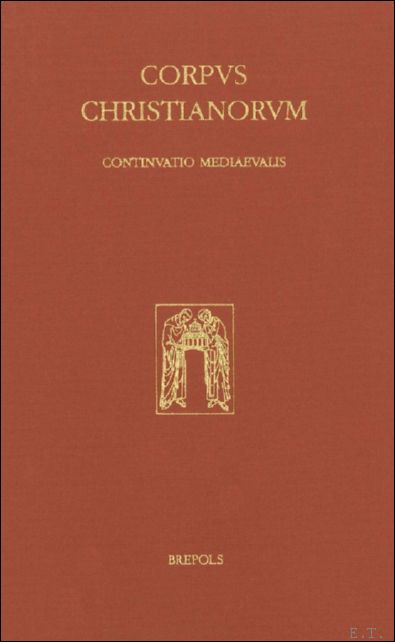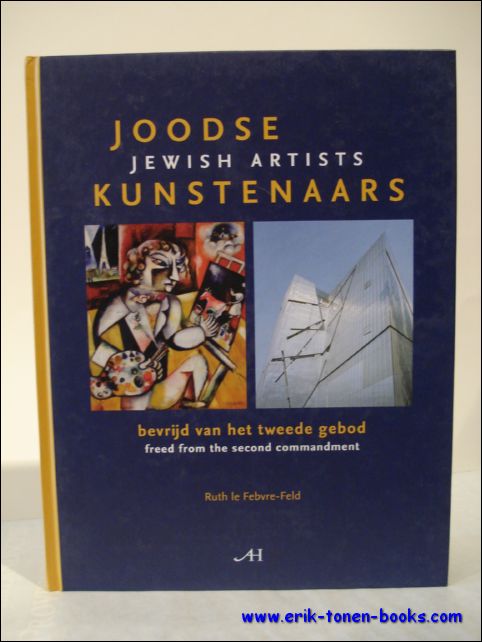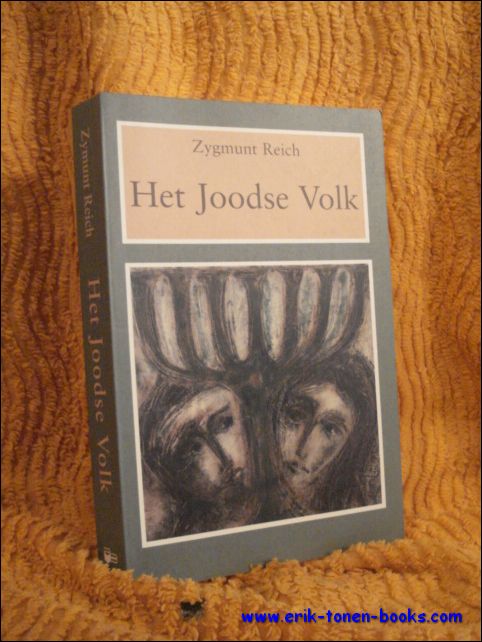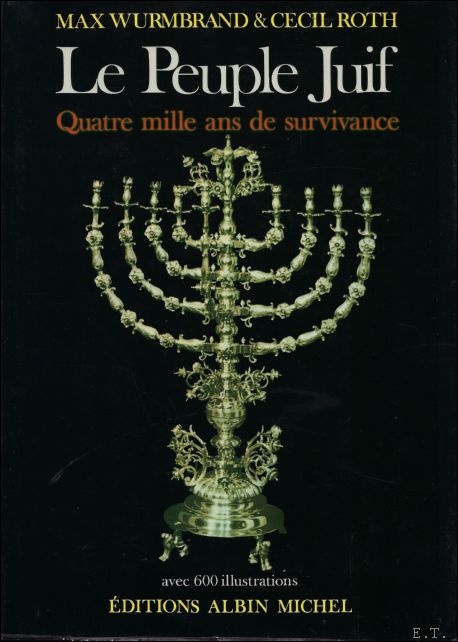Judaisme
13 boeken gevonden
Pagina 1
Alexandre Safran.
La cabale.
Paris, Payot, 1972. 2ieme edition. Broche, 405pp., 14x22.5cm., bon etat (qq. traces d'usage au vouverture).
Boeknummer: 47463 | Prijs: EUR 19.00
Alfred Osborne
The Origins of Christianity in the Calendar Wars of the Second Century BCE
Brepols, 2025. Paperback, 325 pages, Size:156 x 234 mm, Illustrations:2 tables b/w., Language: English. *new ISBN: 9782503613062
Summary In the Gospels Jesus is called a 'Nazarene' or 'Nazoraean'. Does this mean he came from Nazareth? Basing himself on Lidzbarski's analysis of the Hebrew/Aramaic origins of the Greek terms Nazarênos and Nazôraios Dr Osborne proposes that these epithets indicate that Jesus was a nô?rî, a '(Strict) Keeper/Guardian (of the Law)'. This meant he was a follower of the 364-day liturgical calendar known to us from 1 Enoch, Jubilees, and Qumran. An examination of the passages where these terms appear shows that this hypothesis leads to a deeper understanding of the circumstances in which the first Christian communities arose and clarifies greatly the background of Jesus' crucifixion as Y??û ha-Nô?rî. The book then traces the influence of the nô?rîm on the history of Israel from their origin in the 'calendar wars' that tore apart the Jewish nation from 172-163 BCE. These broke out after the lunisolar calendar was introduced into the temple liturgy by Menelaus the high priest, and only came to an end when the 364-day calendar was reintroduced under his successor, Alcimus. In 151 BCE, however, Jonathan Maccabaeus was appointed high priest and reintroduced the lunisolar calendar. The nô?rîm were suppressed and forced to emigrate or go underground. They reappear as leaders of Jewish resistance to Roman occupation after Pompey incorporated Judaea into the empire in 63 BCE. Eventually they became the chief instigators of the revolt against Rome that led to the destruction of Jerusalem in 70 CE. Osborne argues that the nô?rîm thought to have been included in the Twelfth Benediction of the Amidah at Yavneh around 90 CE are these same '(Strict) Keepers/Guardians (of the Law)'. TABLE OF CONTENTS General Introduction and Summary Part One Chapter 1. Introduction: Jesus the Nazarene and Nazoraean Chapter 2. The Meaning of Nazoraean and Nazarene in the New Testament Chapter 3. Jesus as a 'Notsri' in the Gospels Chapter 4. The Nazoraeans in Acts Chapter 5. Conclusion: The Nazarenes and Nazoraeans are Notsrim, 'Keepers (of the Law)' Part Two Chapter 6. Introduction: The Two Calendars and their Characteristics Chapter 7. Onias III (185? - 175 BCE) Chapter 8. Jason (175-172 BCE) Chapter 9. Menelaus (172-163 BCE) Chapter 10. Alcimus (163-159 BCE) Chapter 11. The Unnamed High Priest (159-151 BCE) Chapter 12. Jonathan Maccabeus (152-142 BCE) Chapter 13. The Story that Could Not Be Told Part Three Chapter 14. Introduction Chapter 15. The Hasidim as Notsrim Chapter 16. The 'Fourth Philosophy' and the Sicarii Chapter 17. The Fourth Philosophy and the Notsrim Chapter 18. Summary and Conclusions Part Four Chapter 19. Introduction Chapter 20. The Notsrim Live on in the Liturgy of the Synagogue Chapter 21. The Birkat ha-mînîm in Christian Sources Abbreviations for Editions of Biblical and Non-Biblical Texts, Works of Reference, and Journals Bibliography
Boeknummer: 66495 | Prijs: EUR 75.00
Anonymus (auth), Ulisse Cecini, Óscar Luis de la Cruz Palma (eds)
Extractiones de Talmud, per ordinem sequentialem
Brepols, 2019. Hardback, cx + 712 pages, Size:155 x 245 mm, Illustrations:3 b/w, 1 tables b/w., Languages: Latin, English. ISBN: 9782503582283
Summary In 1239 Pope Gregory IX wrote to kings and bishops across Europe, urging them to seize and examine the manuscripts of the Talmud in their dominions. As a result, a process against the Talmud took place in Paris in 1240. Though the Talmud went up in flames at the Place de la Grève in 1241/42, the controversy on the Talmud continued over the following years, since Gregory's successor, Pope Innocent IV, called for a revision of its condemnation. At the centre of this revision are the 'Extractiones de Talmud', a translation of hundreds of Talmudic passages prepared during the years 1244/45 for Odo of Châteauroux, Legate of the Apostolic See, that served as the basis of his final condemnation of the Talmud in May 1248. This is the first edition of the Latin Talmud, which is a milestone in the long history of Christian-Jewish intellectual encounters.
Boeknummer: 66085 | Prijs: EUR 420.00
Dr. Ruth le Febvre-Feld
Joodse Kunstenaars, bevrijd van het tweede gebod , Jewish Artists, freed from the second commandment
NL, Adr.Heinen, 2006. hardBound, 144 pagina's illustrated in color. new condition !!. ISBN: 9789086800155
Kunsthistorica Dr. Ruth le Febvre-Feld bespreekt in dit boek dat betrekkelijk nieuwe verschijnsel: de Joodse kunstenaar of architect, die bekend is en beroemd en deel uitmaakt van het culturele leven. Aan de orde komen grote namen als Chagall, Israels en Libeskind, maar ook een aantal toonaangevende Israelische kunstenaars, inclusief de Bauhaus-architecten van Tel Aviv en de bewoners van het kunstenaarsdorp Ein Hod.
Boeknummer: 23830 | Prijs: EUR 12.50
Graetz, Heinrich
Volkstumliche Geschichte der Juden. (3 Bande)
Leipzig: Oskar Leiner, s.d. (ca. 1910). Dritte Auflage. Re-bound, blue simili-leather with gilt lettering, 3 vols. 12.5x18cm., XV + 609; 614; 711pp., good complete set.
Boeknummer: 43548 | Prijs: EUR 30.00
KOHLER, LUDWIG
Der Hebraische Mensch. Mit einem Anhang Die Hebraische Rechtsgemeinde.
Tubingen, J.C.B. Mohr, 1953. Bound, green simili-leather, gilt lettering, 180pp., 18.5x11.5cm., good copy.
Boeknummer: 43569 | Prijs: EUR 9.00
POSTHUMA, Roelof;
ZIJ ZULLEN MIJ TOT EEN VOLK ZIJN. DE HISTORIE VAN HET JODENDOM,
De Groot Goudriaan, 2000. Gebonden, geillustreerde kartonomslag, 200 x 260mm., 128pp., zeer mooie en uitgebreid geillustreerd in kleur. ISBN: 9789061405726
Verstrooid onder de volkeren. Jeruzalem. Joodse feesten. De droom verwezenlijkt. Voortgaande terugkeer. Israel en de Palestijnen. 50 jaar Israel : een chronologisch overzicht. Boek is in zeer goede staat.
Boeknummer: 18091 | Prijs: EUR 8.00
REICH, Zygmunt;
HET JOODSE VOLK,
Antwerpen, De Vries. Paperback, 280pp. ISBN: 9789061747772
Dit boek behandelt zowel de geschiedenis, de godsdienst als de levenswijze van het Joodse volk. De in het boek beschreven geschiedenis bestrijkt een ononderbroken periode van 2.500 jaar. Alle tijdperken van deze geschiedenis, de Oudheid, het Hellenisme, de Perzische en Romeinse wereldrijken, het ontstaan van het Christendom en de Islam, de Kruistochten en de Renaissance tot en met de moderne, zijn doordrongen van Joodse geschiedenis en cultuur. De eeuwenlange Joodse bijdrage aan de menselijke ontwikkeling is uniek. Voorts worden de godsdienst en de levenswijze van het Joodse volk beschreven zowel vanuit de vele bronnen als vanuit de eigen ervaringswereld van de schrijver. Nieuw.
Boeknummer: 31711 | Prijs: EUR 20.00
S. Goldin
The Ways of Jewish Martyrdom
Brepols, 2008. XVI+399 p., 0 b/w ill. + 0 colour ill., 7 b/w line art, 160 x 240 mm, Languages: English, Hebrew, Latin
Hardback. ISBN: 9782503525235 Jewish martyrdom in the Middle Ages is a most intriguing social, cultural, and religious phenomenon. It was stimulated by ancient Jewish myths, and at the same time it was influenced by the Christian environment in which the Jews lived and operated. The result was a unique and unprecedented event in which the Jews did not simply refuse to convert to Christianity; they were ready to kill themselves and their children so they would not be forced to convert. The Ways of Jewish Martyrdom discusses the phenomenon of Jewish Martyrdom in medieval Germany, northern France, and England from the time of the First Crusade (1096) until the mid-fourteenth century (that is, the time of the ?Black Death?), in light of modern research and with ample use of hitherto-neglected primary sources. In order to understand the unique phenomenon of Jewish martyrdom, the various Jewish and Christian antecedents that might have influenced the notion of Jewish martyrdom in the Middle Ages need analysis. The texts on which the analysis is based are various, ranging from chronicles through memorial books to liturgical materials and Piyyut. The last part of the book reviews the development of this phenomenon after the fourteenth century and delineates the essential changes and transformations therein at the dawn of the early modern period and beyond. Boeknummer: 49638 | Prijs: EUR 94.50
Hardback. ISBN: 9782503525235 Jewish martyrdom in the Middle Ages is a most intriguing social, cultural, and religious phenomenon. It was stimulated by ancient Jewish myths, and at the same time it was influenced by the Christian environment in which the Jews lived and operated. The result was a unique and unprecedented event in which the Jews did not simply refuse to convert to Christianity; they were ready to kill themselves and their children so they would not be forced to convert. The Ways of Jewish Martyrdom discusses the phenomenon of Jewish Martyrdom in medieval Germany, northern France, and England from the time of the First Crusade (1096) until the mid-fourteenth century (that is, the time of the ?Black Death?), in light of modern research and with ample use of hitherto-neglected primary sources. In order to understand the unique phenomenon of Jewish martyrdom, the various Jewish and Christian antecedents that might have influenced the notion of Jewish martyrdom in the Middle Ages need analysis. The texts on which the analysis is based are various, ranging from chronicles through memorial books to liturgical materials and Piyyut. The last part of the book reviews the development of this phenomenon after the fourteenth century and delineates the essential changes and transformations therein at the dawn of the early modern period and beyond. Boeknummer: 49638 | Prijs: EUR 94.50
SEEWALD, Zahava.
JOODSE SPOREN IN OOSTENDE.
Antwerpen, Pandora, 2000. softcover originele geillustreerde uitgeversomslag in kleur met flappen, 22x24cm, 88pp, geillustreerd in z/w en in kleur. ISBN: 9053251405
Tekst Nederlands/ Francais/ Deutsch. In deze uitgave wordt de aanwezigheid van Joden in Oostende vanuit diverse invalshoeken geillustreerd waaebij niet alleen kunst en literatuur, maar ook geschiedenis en religie aan bod komen.
Boeknummer: 11695 | Prijs: EUR 15.00
Susanna Towers
Constructions of Gender in Late Antique Manichaean Cosmological Narrative
Brepols, 2019. Paperback, 324 pages, Size:156 x 234 mm, Languages: English, Latin. ISBN: 9782503586663
Summary Manichaeism emerged from Sasanian Persia in the third century CE and flourished in Persia, the Roman Empire, Central Asia and beyond until succumbing to persecution from rival faiths in the eighth to ninth century. Its founder, Mani, claimed to be the final embodiment of a series of prophets sent over time to expound divine wisdom. This monograph explores the constructions of gender embedded in Mani's colourful dualist cosmological narrative, in which a series of gendered divinities are in conflict with the demonic beings of the Kingdom of Darkness. The Jewish and Gnostic roots of Mani's literary constructions of gender are examined in parallel with Sasanian societal expectations. Reconstructions of gender in subsequent Manichaean literature reflect the changing circumstances of the Manichaean community. As the first major study of gender in Manichaean literature, this monograph draws upon established approaches to the study of gender in late antique religious literature, to present a portrait of a historically maligned and persecuted religious community. TABLE OF CONTENTS 1. Introduction: This discusses the history of gender studies and its application to religious studies; a summary of previous literature relating to gender in Manichaeism; a brief life of Mani and its relation to his canon of texts. It outlines the contents of the following chapters. 2. The Manichaean Father: exploration and identification of gendered attributes associated with masculinity with reference to Connell's model of hegemonic masculinity. The Manichaean Father is considered as embodiment of desirable masculine traits and the appropriate exercise of masculine rulership and authority. 3. The Chief Archon: This chapter examines the construction of gender implicit in the characterization of the chief archon. Mani's writings characterize the chief archon in polar opposition to the Manichaean Father as exemplum of masculine rulership which embodies lust for power and territory. Mani characterizes the chief archon as a dangerous outsider who seeks to invade. This is expressed through the trope of the cannibal. The chief archon's acts of cannibalism mark him as alien, uncivilized and savage. Manichaean texts written after Mani's death reflect the persecution of the Manichaean community. The characterization of the chief archon develops to reveal a tyrannous ruler who incites fear and terror in his own subjects. 4. The First Man: This chapter considers the apparent paradox of the two competing constructions of masculinity evident in the characterization of the Manichaean First Man, who plays a central role in Manichaean cosmological drama. His characterization as both valiant warrior and suffering victim in defeat is explored in the context of the changing circumstances of the Manichaean community facing persecution. Parallel models of endurance as a worthy expression of masculinity in Jewish, Judaeo-Christian and early Christian literature are discussed. 5. The Mother of Life: This chapter explores the gendered characterization of the Manichaean Mother of Life in Manichaean literature. As mother of the First Man, the Mother of Life embodies positive motherhood, demonstrating nurturing characteristics. Her role in the mythological drama is considered as an expression of the Jewish/Judaeo-Christian literary Wisdom figure (Sophia, Hokmah). The Mother of Life shares and extends imagery attached to Hokmah to encompass wisdom as a weapon. The Mother of Life is also characterized as a model of feminine imprecation to masculine authority through the valorization of her prayer to the Manichaean Father on behalf of the beleaguered First Man. This is discussed in relation to the veneration of Hannah's prayer (1 Sam.) in rabbinic literature. 6. The Manichaean Demoness Az and the yetzer hara: This chapter explores parallels between the feminine-gendered demon Az and the evolving Jewish concept of the "evil inclination" (the yetzer hara) as expressions of the human propensity to sin. As mother of Adam and Eve and mother of the demons, the maternal style of the demoness Az polarizes the motherhood of the Mother of Life. 7. The Maiden of Light: This chapter explores the characterization of the Maiden of Light and her epithets of purity and wisdom in the context of the seductive display of her image to the archons in Manichaean mythology. This act is considered in the context of the model used by feminist biblical scholars of the male as owner of the gaze and the female as object of male gaze. The chapter argues that the characterization of the Maiden of Light should be considered in relation to the biblical characterizations of Susanna, Judith and Esther. These reveal the female as both victim and manipulator of male gaze. These texts reveal that the seeking of male gaze is extolled in cases of communal threat when authorized by masculine authority. It is argued that the seductive display of the Maiden of Light allows doubt concerning the exploitation of females within the Mnichaean community. 8. Conclusions: The conclusion draws together the research findings of the previous chapters. Polarized positions within and across constructions of gender are considered.
Boeknummer: 65896 | Prijs: EUR 75.00
Tamás Visi, Tovi Bibring, Daniel Soukup (eds)
Berechiah ben Natronai ha-Naqdan's Works and Their Reception. L'oeuvre de Berechiah ben Natronai ha-Naqdan et sa réception
Brepols - Ecole Pratique des Hautes Etudes, 2019. Paperback, 254 pages, Size:156 x 234 mm, Languages: English, French. ISBN: 9782503583655
Summary Berechiah ben Natronai ha-Naqdan, the illustrious Jewish scholar from Rouen,was probably the most prolific writer among the twelfth century Jewish authors in France. While all his creations are truly remarkable, two are the focus of this book: Mishlei Shu'alim, the largest compilation of Aesopian fables ever written in Hebrew, and Dodi ve-Nekhdi, a translation of Adelard of Bath's Questiones Naturales. The ten studies gathered here, written by internationally renowned scholars from Europe, Israel and the United States, explore the richness and uniqueness of these two major books, as well as their sources and their reception. A number of these studies accentuate specific themes and motives, some of which are discussed here for the first time. Other studies relate to the linguistic particularities, examined here in a novel and original manner. We also present innovative studies on the Hebrew version of Questiones Naturales, and use vibrant examples to demonstrate the translations, adaptations and uses of Berechiah's works from the Middle Ages until the modern area. This volume is the result of an international workshop that was held in the Center for Jewish Studies in Palacky University in May 2015. TABLE OF CONTENTS Preface and Acknowledgements Tamás Visi, Introduction. Berechiah ben Natronai ha-Naqdan and His Works Tovi Bibring, Juif ou Français ? Berechiah ha-Naqdan au carrefour culturel : nouvelles considérations sur « Souris et Grenouille » Part I. The Mishlei Shu?alim Revital Refael-Vivante, Charity as a Value and a Norm in Mishlei Shu?alim by Rabbi Berechiah ha-Naqdan Cyril aslanov, Can the Language of Mishlei Shu?alim Give us a Clue about Berechiah ha-Naqdan's Geographical Origin? Part II. The Scientific Works Tamás Visi, Science and Religion in Ashkenaz. Berechiah ben Natronai ha-Naqdan and his Predecessors Hagar Kahana-smilansky, The Sources of Berechiah's Book of Questions, Illustrated by the Questions on Ocular Vision and 'Melancholic' Animals Part III. Berechiah's Reception in the Middle Ages Rella Kushelevsky, Berechiah's Imprint on Sefer ha-ma'asim: The Reception of Mishlei Shu?alim Andreas lehnardt, "I Saw in a Town Violence and Strife" - An Unknown Ashkenazic Maqama Found in a Binding Fragment Part IV. Berechiah's Reception in the Early Modern and Modern Period Magdaléna Jáno?íková, Fox Fables in the Early Modern Era. The Fables that Ashkenaz Read in Hebrew Daniel Soukup, Melchior Hanel (1627-1689) and his Latin Translation of Mishlei Shu?alim in the Context of the Respublica Litteraria Ellen Frankel, Twice-Translated Tales. Creating Contemporary English Versions of the Fox Fables of Berechiah ben Natronai Ha-Naqdan Abstracts in French
Boeknummer: 66071 | Prijs: EUR 70.00
WURMBRAND, MAX/ ROTH, CECIL.
LE PEUPLE JUIF QUATRE MILLE ANS DE SURVIVANCE.
Paris, Albin Michel, 1967. Relie en toile rouge, dore sur le plat, dos orne dore, frontispice en couleur, 19x27cm, 477pp, illustre n/b.
Traduction de Raymond Albeck.Nouvelle eition revue et augmentee. 600 illustrations.
Boeknummer: 6852 | Prijs: EUR 10.00
Pagina 1





















